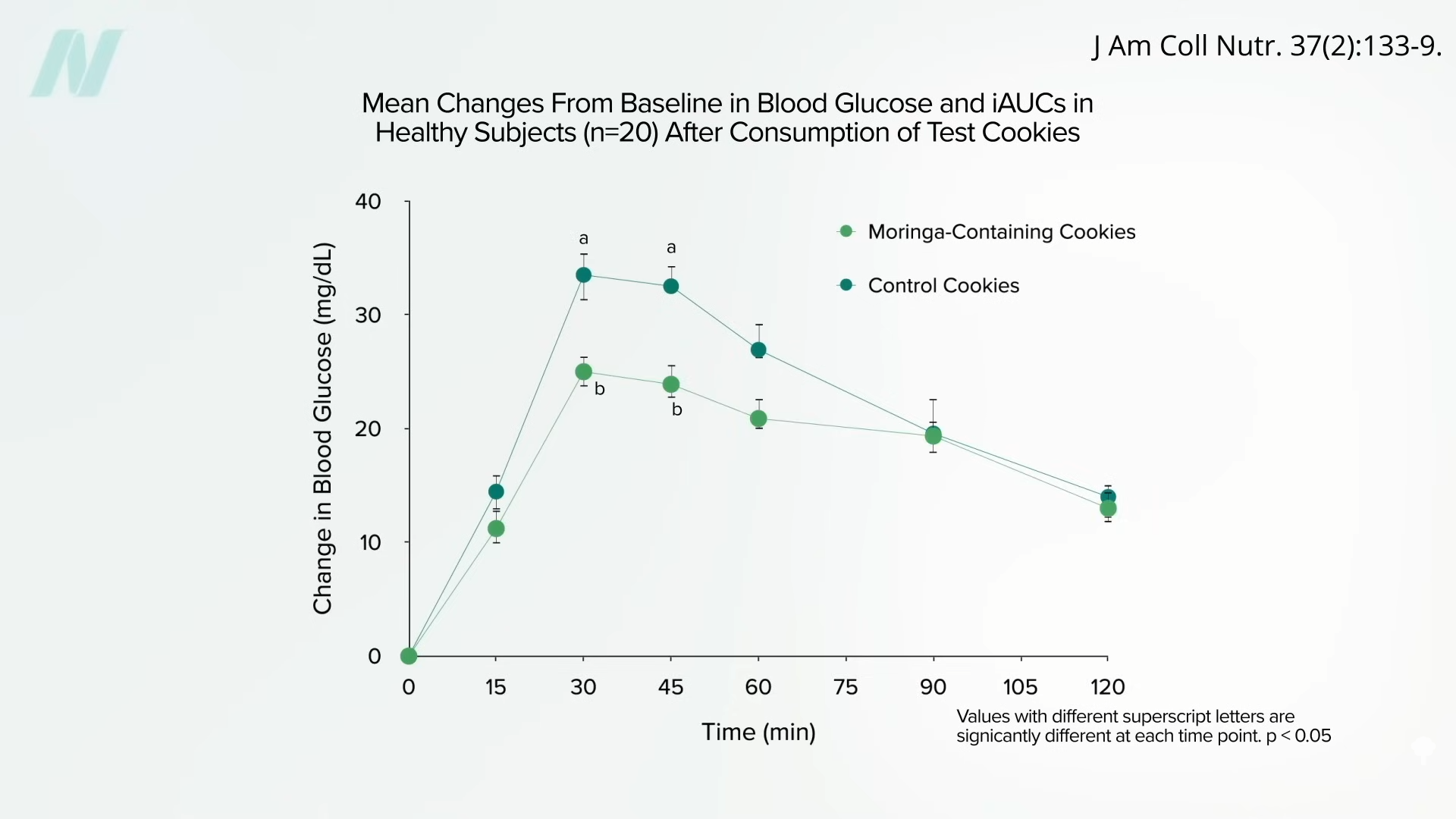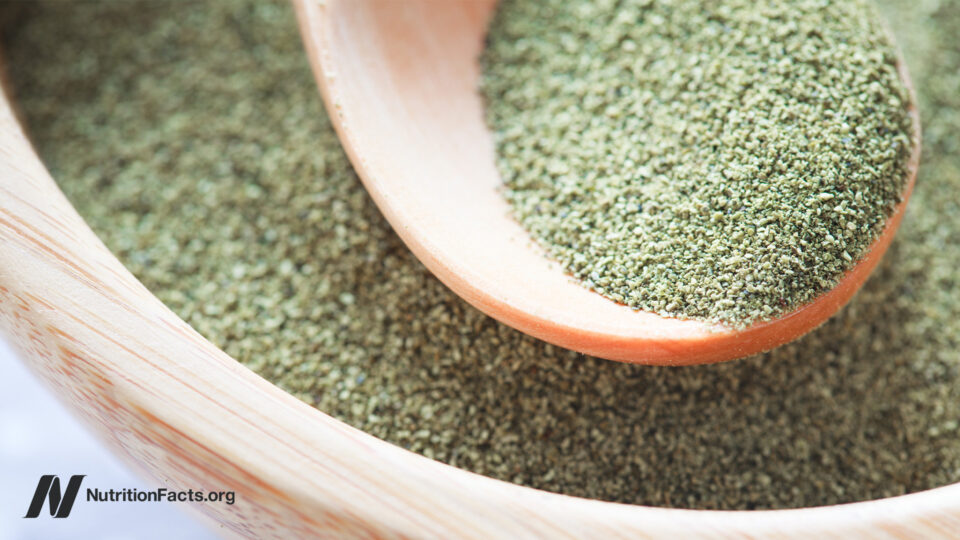“Clearly, in spite of the widely held ‘belief’ in the health benefits of M. oleifera [moringa], the interest of the international biomedical community in the medicinal potential of this plant has been rather tepid.” In fact, it has been “spectacularly hesitant in exploring its nutritional and medicinal potential. This lukewarm attitude is curious, as other ‘superfoods’ such as garlic and green tea have enjoyed better reception,” but those have more scientific support. There are thousands of human studies on garlic and more than ten thousand on green tea, but only a few hundred on moringa.
The most promising appears to be moringa’s effects on blood sugar control. Below and at 0:55 in my video The Efficacy and Side Effects of Moringa Leaf Powder, you can see the blood sugar spikes after study participants ate about five control cookies each (top line labeled “a”), compared with cookies containing about two teaspoons of moringa leaf powder into the batter (bottom line labeled “b”). Even with the same amount of sugar and carbohydrates as the control cookies, the moringa-containing cookies resulted in a dampening of the surge in blood sugar.

Researchers found that drinking just one or two cups of moringa leaf tea before a sugar challenge “suppressed the elevation in blood glucose [sugar] in all cases compared to controls that did not receive the tea initially” and instead drank plain water. As you can see here and at 1:16 in my video, drinking moringa tea with sugar dampened blood sugar spikes after 30 minutes of consumption of the same amount of sugar without moringa tea. It’s no wonder that moringa is used in traditional medicine practice for diabetes, but we don’t really know if it can help until we put it to the test.
 People with diabetes were given about three-quarters of a teaspoon of moringa leaf powder every day for 12 weeks and had significant improvements in measures of inflammation and long-term blood sugar control. The researchers called it a “quasi-experimental study” because there was no control group. They just took measurements before and after the study participants took moringa powder, and we know that simply being in a dietary study can lead some to eat more healthfully, whether consciously or unconsciously, so we don’t know what effect the moringa itself had. However, even in a moringa study with a control group, it’s not clear if the participants were randomly allocated. The researchers didn’t even specify how much moringa people were given—just that they took “two tablets daily with one tablet each after breakfast and dinner,” but what does “one tablet” mean? There was no significant improvement in this study, but perhaps the participants weren’t given enough moringa. Another study used a tablespoon a day and not only saw a significant drop in fasting blood sugars, but a significant drop in LDL cholesterol as well, as seen below and at 2:27 in my video.
People with diabetes were given about three-quarters of a teaspoon of moringa leaf powder every day for 12 weeks and had significant improvements in measures of inflammation and long-term blood sugar control. The researchers called it a “quasi-experimental study” because there was no control group. They just took measurements before and after the study participants took moringa powder, and we know that simply being in a dietary study can lead some to eat more healthfully, whether consciously or unconsciously, so we don’t know what effect the moringa itself had. However, even in a moringa study with a control group, it’s not clear if the participants were randomly allocated. The researchers didn’t even specify how much moringa people were given—just that they took “two tablets daily with one tablet each after breakfast and dinner,” but what does “one tablet” mean? There was no significant improvement in this study, but perhaps the participants weren’t given enough moringa. Another study used a tablespoon a day and not only saw a significant drop in fasting blood sugars, but a significant drop in LDL cholesterol as well, as seen below and at 2:27 in my video.
 Two teaspoons of moringa a day didn’t seem to help, but what about a third, making it a whole tablespoon? Apparently not, since, finally, a randomized, placebo-controlled study using one tablespoon of moringa a day failed to show any benefit on blood sugar control in people with type 2 diabetes.
Two teaspoons of moringa a day didn’t seem to help, but what about a third, making it a whole tablespoon? Apparently not, since, finally, a randomized, placebo-controlled study using one tablespoon of moringa a day failed to show any benefit on blood sugar control in people with type 2 diabetes.
So, we’re left with a couple of studies showing potential, but most failing to show benefit. Why not just give moringa a try to see for yourself? That’s a legitimate course of action in the face of conflicting data when we’re talking about safe, simple, side–effect–free solutions, but is moringa safe? Probably not during pregnancy, as “about 80% of women folk” in some areas of the world use it to abort pregnancies, and its effectiveness for that purpose has been confirmed (at least in rats), though breastfeeding women may get a boost of about half a cup in milk production based on six randomized, blinded, placebo-controlled clinical trials.
Just because moringa has “long been used in traditional medicine” does not in any way prove that the plant is safe to consume. A lot of horribly toxic substances, like mercury and lead, have been used in traditional medical systems the world over, but at least “no major harmful effects of M. oleifera [moringa]…have been reported by the scientific community.” More accurately, “no adverse effects were reported in any of the human studies that have been conducted to date.” In other words, no harmful effects had been reported until now.
Stevens-Johnson syndrome (SJS) is probably the most dreaded drug side effect, “a rare but potentially fatal condition characterized by…epidermal detachment and mucous membrane erosions.” In other words, your skin may fall off. Fourteen hours after consuming moringa, a man broke out in a rash. The same thing had happened three months earlier, the last time he had eaten moringa, causing him to suffer “extensive mucocutaneous lesions with blister formation over face, mouth, chest, abdomen, and genitalia.” “This case report suggests that consumption of Moringa leaf is better avoided by individuals who are at risk of developing SJS.” Although it can happen to anyone, HIV is a risk factor.
My take on moringa is that the evidence of benefit isn’t compelling enough to justify shopping online for something special when you can get healthy vegetables in your local market, like broccoli, which has yet to be implicated in any genital blistering.

